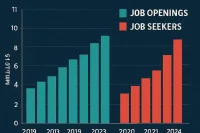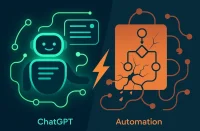8 rules for learning to code in 2025
8 rules for learning to code in 2025 starts with a crucial question: should you still learn programming when AI seems to be taking over? Some people are 100% certain that there’s no need for anyone to learn to code anymore—AI will take over soon, so all people interested in it should look elsewhere for opportunities like plumbing. Well, I strongly disagree, and you have a right to disagree with me. I’m not hating, but let me point out a few things.
First, the biggest use case for AI right now is web and mobile app development. Sounds like a problem, right? Well, yes, until you see that only 6.1% of US companies are using AI in their business. Yes, while Microsoft, Amazon, and the like fill your news feeds daily, they are not the only companies that exist. To add to that, developers make up only 2.5% of the workforce, and it’s only natural that we are going to flock to this technology being technical people and not the bank teller whose job will be replaced in the future.
So 94% of US companies are not using AI. When they decide to, I want to be on the technical side of things. I want to be at the forefront of innovation with the skills to join in. Another thing is AI consulting and AI startups are blowing up right now. People using low-code and no-code tools are able to get an MVP of their app up and running without needing to know any code at all. That’s great, but 100% of them go on to say this: when you get this MVP up and you start getting customers, then you’ll need to hire a dev team to turn that app into what you actually want it to be. That’s you and that’s me.
So the economy is what it is—it’s tough—but the job listings are still there. They didn’t disappear. Everyone is still hiring devs, and 94% of companies are not using AI. As AI continues to be adopted, it will be the technical people that understand coding and problem-solving leading the way into new frontiers. Sure, you’ll need to adapt along the way. Everything won’t remain the same as it is now, but learning to code right now is not a lost cause.
Again, feel free to differ with me—that’s fine. If you come to that conclusion, that’s okay. At the end of the day, we all have to make our own decisions, but I think those who want to get into it with hard work and realistic expectations can still do so. But listen closely—it’s not for everyone. This is where things get real. Not everyone will succeed in this field. In fact, there are certain traits that make you more prone to fail than others, which is why so many do.
So what I want to do here is give you eight rules for learning to code in 2025 should you choose to do so. These eight rules are going to help you determine if you should learn to code, if you’ll be successful or not, and some of the steps you’ll be forced to take along the way. These are eight things you will have to do. Let’s get started.
Rule 1: You have to love it
This is where things are different today. 5 to 6 years ago, there was a huge demand and you could find your way in without really loving it. You’re probably loving the paycheck or the starting salaries but not really loving the coding part of it, and this may be why we now have so many people tired of what they do. Yes, there are more and more videos, threads, and articles about people hating what they do despite making good money or having reached a point in their life where they always wanted to be.
So first, if you try it out and fall in love with it, it may just be for you and it may be a pursuit that you can succeed at. But if you’re like “eh,” then it’s going to be a tough road. When I learned, it was easier to get in, yes, but I knew at that point I had to do it whatever it took. I loved it that much. Make sure you do as well.
Rule 2: You have to put in the work
There’s no shortcut to learning to code. Yes, AI can write HTML and CSS very well and can give us all the answers we need, but you still need to learn it. You can’t skip CSS if you want to be a front-end dev. You can’t skip JavaScript and learning about the DOM and promises and all of that. And you have to get good at it, and you have to be able to solve problems with it and build projects with it. And this takes time, and this is where many people fall off the path.
And it’s probably for the best. If you write Python for 3 months and you’re so sick of doing it to reach your goals, then perhaps you don’t really want to do this type of job or perhaps you’re wasting your time or on the wrong path overall. In addition, this is where you have to set a clear path of how you’re going to learn and what end goal you’re going to be at and see it through.
Because we have AI now doesn’t mean you get shortcuts. It’ll be a lot of work, but you have to put in the hours and you have to write a ton of code to learn the craft and make yourself employable. If you were to put in 9 months of coding and had a solid foundation and then AI takes a huge leap forward, you still have this umbrella of dev skills and understand what’s happening under the hood and can take it further than anyone using low or no-code could ever imagine. You actually have a foundation that is prime for this upcoming AI market, but you have to put in the work. You have to write a lot of code and learn the craft.
Rule 3: You have to live it
Now this is a trait I see of developers who continue to succeed day in and day out in this industry. They live this stuff. Their Twitter’s filled with coding stuff, their blog is technical, they keep up with the latest software news and updates, and they literally live it. They don’t get tired of it. There’s a guy in the Travis Media community who’s been hiring devs for many years, and he said the number one trait he looks for in a hire is that the person actually loves what they do. They have an active GitHub, they have a blog in which they write tech articles, and they’re demonstrating day by day that they actually love what they do.
And I’m saying all this in the context of it being a tough economy where it’s not at all the easiest task to get employed or stay employable currently. It demands those who can’t see themselves doing anything else. If this becomes you, then I think you’ll do well.
Rule 4: You have to be specific
You will not succeed without a specific plan of how you will learn to code and how much time you will set aside to do so. If you say “I want to learn to code in 2025 and become employable,” then I want to see a diagram of each course you will take along the way through to the end. Yes, you need to be this specific in your plan. This includes what week and month you plan to be in a certain course, what lesson number you’ll be on and when, and you need to be able to check this off as you go. The more specific, the better.
For example, if you’re going to take Colt Steele’s 74-hour web developer bootcamp course on Udemy, first you would buy it on discount by checking when the next Udemy sale is on my website at travis.media/udemy as it’s updated regularly with all Udemy discounts. And second, you would look how long each section is, assess how hard you think it’ll be to pick up, find out where the projects are and how much time they will take, and you’ll create a plan for taking this course—a timeline of when to do what. For instance, 2 weeks in HTML, 3 weeks in CSS section, one week for the pricing panel project just to really nail it down, three weeks in these three JavaScript sections, and so on.
And you’re going to get a paper or you’re going to use an app like MeisterTask to create a timeline. If you need an idea, check out my blueprints that I’ve created and how I’ve structured the work there—link to those below. But you will not succeed unless you’re extremely specific with your plan of action.
Turn Your Plan Into Action
A vague goal won’t get you hired—specific plans do. Once you’ve mapped out your learning path, take the next step by connecting with real job opportunities. Post your resume or explore jobs on WhatJobs today and put your skills to work.
Post a Job Free for 30 Days →Rule 5: You have to put on blinders
Blinders, or blinkers as I think they’re actually called, sit on each side of a horse’s eyes to blind them to what’s going on around them and keep them focused only on what’s ahead. So you’ve created a very specific plan of action. Now the biggest adversary to come your way will be distraction. It will be others telling you that you should be learning something different or you should be using Vim or learning some obscure thing along the way. This will happen, and you will fail. It’s actually what happens to most people.
If you really want something, you have to have a specific plan and you have to do specific drastic things that will keep you on that path without veering from it. Think about it—if you allot 9 months to get through this course and you build all the projects, etc., if you somehow could push through all 9 months without a hiccup, without distractions, you would look back and be like “man, I have learned a ton and I have made so much progress.” But most 9 months from now will still be looking up better paths or quicker paths and will still be in the same position they’re in now, just spinning wheels and getting nowhere.
Find a way to lose all distractions and get from A to Z successfully.
Rule 6: You have to network
This is really another step that will make or break your whole pursuit because you have nothing or no one at all to really vouch for your abilities aside from a portfolio and your word that you can actually code. So either they take a wild chance on you or you have some sort of connection that can help you get in the door that can vouch for you in your ability to do the job.
If you go now and ask anyone who has done this, they will say that networking is the number one part of the whole process. In fact, networking should be a part of your entire career—making connections along the way, helping others, asking for their help, keeping in touch periodically with people in your network, and moving between jobs and opportunities within and because of your network. It’s actually a real science to it.
If you try and do all this solo in the corner, shut out from the world, you will have no one to lift you up when you’re ready to hit the job market. And while it won’t be impossible, it will be much, much harder to do it alone. So you have to network along the way. You have to make connections with others doing the same thing as you, others who are ahead of you, and you have to follow those who have already been successful.
In addition, you should be active on social media as well. Force people to see your profile pic and your tweets daily. Start to write regularly and begin to form and share your opinions. Then when the time comes, you could potentially have a following that also will help you get in the door. I have a video all about these techniques—I’ll link to it above. Go and watch that and be sure you’re networking along the way.
Rule 7: You have to overcome your fears
In fact, you will be forced to overcome them the moment you think that you’re ready to start applying for jobs. This one will be important. To take this self-taught, self-learning path into this industry, you’re going to have to do things that you’re not used to doing. It will actually feel pretty crazy when you get to the stage where you start applying for jobs. You will feel more like quitting the whole thing before you go and find yourself placed in a technical interview. I mean, who are you to try to convince people that you have the training and what it takes to be trusted in their corporate codebase?
So if you want to go down this path, just know that you will have to really get out of your comfort zone. I know this is a cliché statement, but this will push your limits. If you can’t do this, then you will put in all that work for nothing, and that’s what happens to many. They put in all this work just to quit at the end. You’ll have to get to a point where you believe that you have put in the needed time, you understand the craft, and can be okay about failing the first few technical interviews.
Rule 8: You have to mute AI
Let’s circle back around to AI here. AI can help you learn to code if used properly, but it’s all too easy to begin to rely on it without actually having to learn the material, and this is a recipe for disaster down the road. You’ll be able to use AI as a sidekick, but if you’re in the process of learning programming, you should not be using AI for any of this. Again, it will benefit you down the road—there will come a day—but at this point, you should learn without it. Get the fundamentals down without it. Wrestle with learning the material on your own.
There will be a lot of temptation to use it, a lot of pressure online to use it, but don’t do it. Use it for other tasks but not for coding. Otherwise, you’ll be the one having to call in the dev team once the MVP is up, and to be honest, you won’t be needed for the MVP either.
The reality of learning to code in 2025
So these are eight traits that I think will have to be in place for you to succeed at this. The economy currently is not in your favor. Any route is difficult, especially the self-taught route, but it is doable. It’s completely doable, but it will take hard work and will demand much of you in the process.
The key is understanding that while AI is changing the landscape, it’s not replacing the need for skilled developers. Instead, it’s creating new opportunities for those who understand both coding and how to work with AI tools effectively. The developers who will thrive are those who can leverage AI as a tool while maintaining deep technical knowledge and problem-solving skills.
Why coding is still relevant in 2025
Despite the AI hype, coding remains one of the most valuable skills you can learn. Here’s why:
1. AI creates more coding jobs, not fewer – Every AI tool needs developers to build, maintain, and improve it
2. Technical understanding is irreplaceable – You need to understand code to work effectively with AI tools
3. Problem-solving skills are timeless – The ability to break down complex problems and find solutions will always be valuable
4. Adaptability is key – Learning to code teaches you how to learn, which is crucial in a rapidly changing tech landscape
The future of programming careers
The future belongs to developers who can:
– Write clean, maintainable code
– Work effectively with AI tools
– Understand both the technical and business sides of projects
– Continuously learn and adapt to new technologies
– Solve complex problems that AI alone cannot handle
Getting started with your coding journey
If you’ve decided that learning to code is right for you, here’s how to begin:
1. Choose your first language wisely – Python, JavaScript, or Java are great starting points
2. Find a structured learning path – Look for comprehensive courses that take you from beginner to job-ready
3. Build projects from day one – Don’t just watch tutorials; write code and build things
4. Join a community – Find other learners and experienced developers to learn from
5. Set realistic timelines – Expect 6-12 months of dedicated learning before you’re job-ready
Common mistakes to avoid
Many aspiring developers fail because they:
– Jump between languages and frameworks too quickly
– Focus on tutorials instead of building projects
– Try to learn everything at once
– Give up when they hit their first major roadblock
– Don’t practice problem-solving and algorithmic thinking
The importance of persistence
Learning to code is hard. You will get frustrated. You will feel like you’re not making progress. You will want to quit. This is normal. The key is to push through these difficult moments and keep going. Every developer has been where you are, and every successful developer has overcome these same challenges.
Building a portfolio that stands out
Your portfolio is your most important asset when looking for your first job. Focus on:
– Building 3-5 high-quality projects that demonstrate different skills
– Writing clean, well-documented code
– Deploying your projects so employers can see them in action
– Contributing to open-source projects
– Writing about your learning journey and projects
Preparing for the job market
When you’re ready to start applying for jobs:
– Practice coding interviews regularly
– Build a strong LinkedIn presence
– Network with other developers and potential employers
– Apply to jobs even if you don’t meet all the requirements
– Be prepared to start with internships or junior positions
The long-term benefits of learning to code
Learning to code provides benefits beyond just getting a job:
– Improved problem-solving skills
– Better understanding of technology
– Increased earning potential
– Ability to build your own projects and startups
– Transferable skills that apply to many other fields
FAQs
Q: Is it still worth learning to code in 2025 with AI advancing so rapidly?
A: Yes, absolutely. While AI is changing the landscape, it’s creating more opportunities for skilled developers who can work with AI tools effectively. The demand for developers continues to grow, and technical skills remain highly valuable.
Q: How long does it take to learn to code and get a job?
A: With dedicated effort, most people can become job-ready in 6-12 months. However, this depends on your background, the time you can commit, and how quickly you can learn. The key is consistency and building real projects.
Q: What programming language should I learn first?
A: Python, JavaScript, or Java are excellent choices for beginners. Python is great for data science and AI, JavaScript for web development, and Java for enterprise applications. Choose based on your interests and career goals.
Q: Do I need a computer science degree to become a developer?
A: No, many successful developers are self-taught or have learned through bootcamps and online courses. What matters most is your ability to code, solve problems, and build projects that demonstrate your skills.
Live example — user point of view
I started learning to code in 2023 when everyone was saying AI would replace developers. I was working as a marketing coordinator making $45,000 per year and felt stuck in my career. When I discovered the 8 rules for learning to code in 2025, particularly the emphasis on loving the work and putting in the hours, I knew I had to give it a real shot.
I chose Python as my first language because I was interested in data science and AI. Following rule 4, I created a detailed 9-month learning plan with specific courses, projects, and timelines. I spent 2-3 hours every evening after work coding, and my weekends were dedicated to building projects.
The hardest part was rule 7—overcoming my fears. When I started applying for jobs after 8 months of learning, I felt like an impostor. I had no computer science degree, no formal training, just a portfolio of projects I’d built. But I pushed through the fear and applied to 50+ positions.
My networking efforts (rule 6) paid off when a developer I’d connected with on Twitter referred me to his company. They were looking for a junior Python developer, and my portfolio of data analysis projects using Python libraries impressed them. I got the job and now make $75,000 per year as a data engineer.
The 8 rules for learning to code in 2025 literally changed my life. I went from feeling stuck in a dead-end job to having a fulfilling career with unlimited growth potential. The key was following all the rules, especially loving the work and putting in the consistent effort required to succeed.




